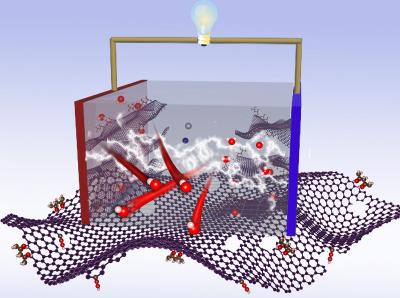Novel approach improves graphene-based supercapacitors

An efficient pathway to improve performance of supercapacitors Credit: Dawei Su
Demand for integrated energy storage devices is growing rapidly as people rely more and more on portable and wireless electronics, and the global need grows for clean energy sources such as solar and wind energies.
This is creating an exponential need for advanced energy storage technologies – reliable and maintenance-free batteries and supercapacitors (SC) with high power density capability as storage devices. Supercapacitors are prominent candidates to meet this need due to their environmentally friendly and long cyclability characteristics.
Researchers from the Integrated Nano Systems Lab (INSys Lab), in the Centre for Clean Energy Technology, have been working on a pathway to improve the performance of supercapacitors, and meet that demand for increased storage capacity.
Dr Mojtaba Amjadipour and Professor Francesca Iacopi (School of Data and Electrical Engineering) and Dr Dawei Su (School of Mathematical and Physical Sciences) describe their cutting-edge work in the July 2020 issue of the journal Batteries and Supercaps.
The prominence given to Graphitic-Based Solid-State Supercapacitors: Enabling Redox Reaction by In Situ Electrochemical Treatment – designated a Very Important Paper with front coverage placement – signifies just how innovative their research is in developing alternate ways to extend storage capacity.
Dr Iacopi said the multi-disciplinary approach within the team was beneficial in discovering what she says is a simple process.
“This research has originated from our curiosity of exploring the operation limits of the cells, leading us to unforeseen beneficial results. The control of this process would not have been possible without understanding the fundamental reasons for the observed improvement, using our team's complementary expertise.”
Traditionally, supercapacitors are fabricated with liquid electrolytes, which cannot be miniaturised and can be prone to leakage, prompting research into gel-based and solid-state electrolytes. Tailoring these electrolytes in combination with carbon-based electrode materials such as graphene, graphene oxide, and carbon nanotubes is of paramount importance for an enhanced energy storage performance.
Graphene or graphitic carbon directly fabricated on silicon surfaces offers significant potential for on-chip supercapacitors that can be embedded into integrated systems. The research insights indicate a simple path to significantly enhance the performance of supercapacitors using gel-based electrolytes, which are key to the fabrication of quasi-solid-(gel) supercapacitors.
“This approach offers a new path to develop further miniaturized on-chip energy storage systems, which are compatible with silicon electronics and can support the power demand to operate integrated smart systems,” Dr Iacopi said.
Media Contact
All latest news from the category: Information Technology
Here you can find a summary of innovations in the fields of information and data processing and up-to-date developments on IT equipment and hardware.
This area covers topics such as IT services, IT architectures, IT management and telecommunications.
Newest articles

Pinpointing hydrogen isotopes in titanium hydride nanofilms
Although it is the smallest and lightest atom, hydrogen can have a big impact by infiltrating other materials and affecting their properties, such as superconductivity and metal-insulator-transitions. Now, researchers from…

A new way of entangling light and sound
For a wide variety of emerging quantum technologies, such as secure quantum communications and quantum computing, quantum entanglement is a prerequisite. Scientists at the Max-Planck-Institute for the Science of Light…

Telescope for NASA’s Roman Mission complete, delivered to Goddard
NASA’s Nancy Grace Roman Space Telescope is one giant step closer to unlocking the mysteries of the universe. The mission has now received its final major delivery: the Optical Telescope…



